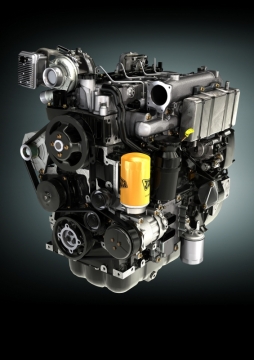Massive Investment by JCB Results in Clean Burning Power Plants
With every challenge comes an opportunity for industry innovation, so says JCB, the global equipment manufacturer, famed for its English backhoe brand. JCB has made one of the biggest investments in its history to develop one of the off-highway sector’s cleanest engines, in readiness for incoming emissions legislation. The company has invested around £80 million in researching and developing a new combustion system for the new JCB Ecomax T4 4.4 litre engine — the latest generation of JCB Dieselmax engines. The investment has delivered an industry-first solution, says the company, which eliminates the need for any exhaust after-treatment and delivers cost savings for mid-range customers.
 “Meeting Tier 4 emissions legislation is a massive challenge but also a huge opportunity for innovation,” says Alan Tolley, JCB’s Director of Engine Programmes. “It’s an opportunity to come up with a solution that has real advantages for our customers. We believe the result is not only the off highway sector’s cleanest engine, but a first for our industry.
“Meeting Tier 4 emissions legislation is a massive challenge but also a huge opportunity for innovation,” says Alan Tolley, JCB’s Director of Engine Programmes. “It’s an opportunity to come up with a solution that has real advantages for our customers. We believe the result is not only the off highway sector’s cleanest engine, but a first for our industry.
The engine is now undergoing full in-field testing before going into production in 2012 to meet Tier 4 interim/Stage 3B legislation.
The key benefits of the innovation are:
Reduced fuel consumption
Reduced cost of ownership
Better reliability
Better packaging and no compromise of machine design
“The expectation for the first part of Tier 4 interim/Stage 3B legislation was that to achieve these really low particulate levels you needed to fit a Diesel Particulate Filter [DPF],” says Tolley. “But when you look at that technology for our particular part of the market, namely mid-range construction equipment, we see there are some real disadvantages with that solution, in particular increased fuel consumption through increased back pressure to the engine. Also, in many applications load cycles are light and the DPF doesn’t self regenerate so you have to force it to do so and it needs fuel to do it.
“Our strategy therefore has been to meet Tier 4 interim emission standards without a DPF but also to achieve this without any exhaust after-treatment. We have focused our research and development efforts on a high efficiency combustion system; in other words we have made sure we don’t create the pollutants to start with rather than try and deal with them later. This approach also gives us very low fuel consumption levels.
As well as there being no need to fit a costly exhaust after-treatment system, there has been no requirement to increase the cooling pack size or to reduce service intervals from their standard 500 hours. In addition, under test conditions, the engines have been achieving a 5 to 10 per cent fuel consumption improvement compared to the previous generation.
The engine design is also future-proofed, as the structural architecture, the componentry and systems will remain the same for Stage 4/Tier 4 Final regulations in the future, at which time exhaust after-treatment for NOx reduction may be unavoidable.





Comments are closed here.